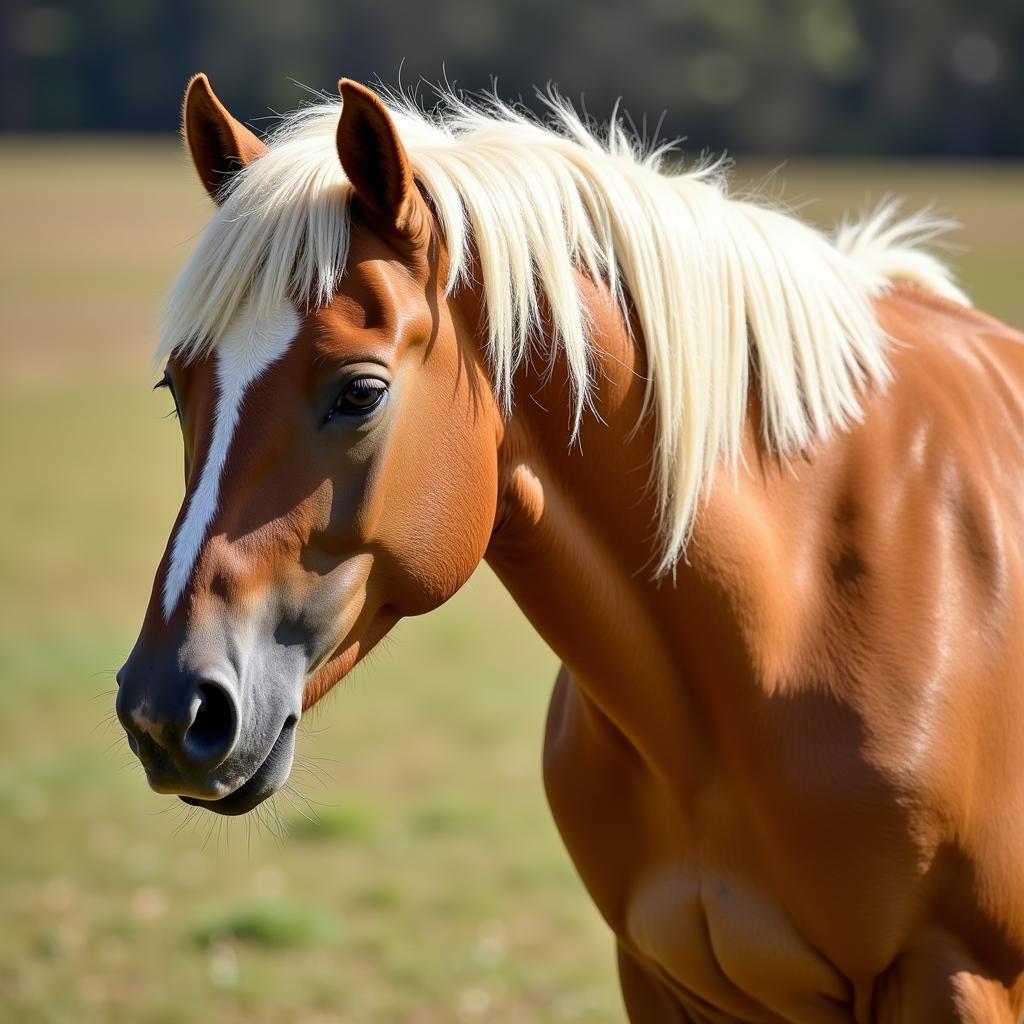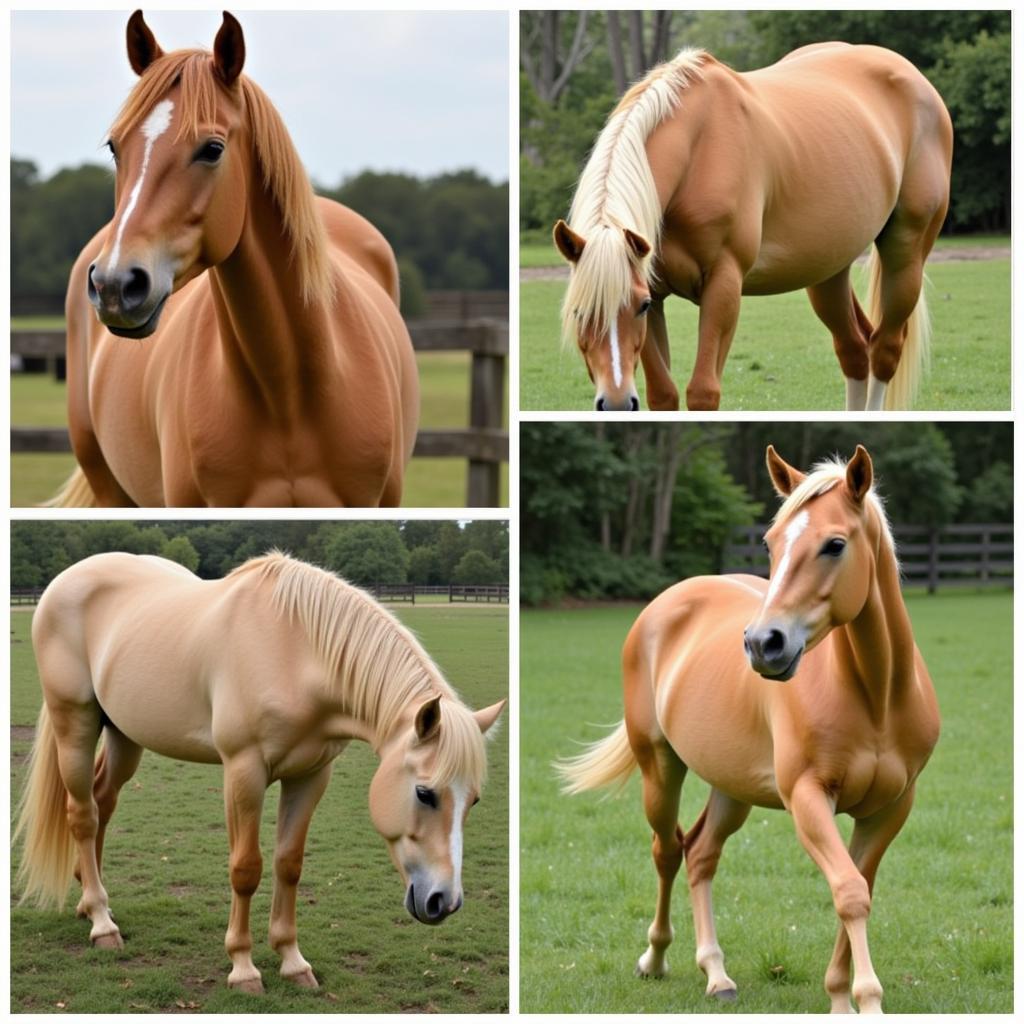Palomino is a striking horse coat color, not a breed. It’s characterized by a golden coat and a white or cream mane and tail. This beautiful coloration often leads to confusion, with many people wondering if Palomino horses represent a distinct breed. Let’s delve into the world of equine coat colors and clarify the distinction.
Understanding the difference between breed and color is crucial in the equine world. A breed refers to a group of horses with specific characteristics, including conformation, temperament, and often, a predisposition to certain coat colors. These traits are passed down consistently through generations. Color, on the other hand, simply refers to the pigmentation of the horse’s hair coat, mane, and tail. While certain breeds might be known for particular colors, color itself doesn’t define a breed. Just like what color are horses can vary widely, so too can the colors within a single breed.
What Defines a Palomino Horse?
The shimmering gold coat, reminiscent of a newly minted coin, is the hallmark of the Palomino. This base coat color ranges from a light, almost creamy gold, to a deep, rich hue reminiscent of burnished copper. Accompanying this golden coat is a flaxen mane and tail, typically white or cream colored, creating a striking contrast. The genetics behind this unique coloration involve a single cream dilution gene acting upon a chestnut base coat. This explains why you can find Palominos in a variety of horse breeds, from American Quarter Horses to Morgan Horses and even Shetland Ponies. The consistent factor is the genetic combination that produces the desired color.
 Palomino Horse with Golden Coat and White Mane
Palomino Horse with Golden Coat and White Mane
Can Any Breed Be a Palomino?
Yes, virtually any breed can produce a Palomino. The color isn’t restricted to a specific breed, just as you might find different colors within what color is a roan horse. As long as the horse carries the correct genetic combination—a chestnut base coat and a single cream dilution gene—the Palomino color can appear. This is why you’ll see Palominos in a wide array of breeds, each exhibiting the breed’s typical conformation and characteristics, but sharing the distinctive golden coat.
The Genetics of the Palomino Color
The Palomino color is the result of a delicate genetic dance. It requires a chestnut base coat and a single copy of the cream dilution gene (Cr). If a horse inherits two copies of the cream gene, it becomes a cremello, a horse with a pale cream or almost white coat, pink skin, and blue eyes. If the horse has no cream gene, it remains a chestnut. The presence of a single cream gene creates the magic of the Palomino. This is why breeding for Palomino color can be challenging, as it involves predicting the inheritance of this specific genetic combination. You might be curious about what color will my foal be when breeding two Palominos? It’s not always a guaranteed outcome.
 Palomino Horses in Different Breeds
Palomino Horses in Different Breeds
Common Misconceptions about Palominos
One common misconception is that Palominos are always calm and gentle. While some may possess these traits, temperament is largely determined by breeding and individual personality, not color. Just like understanding the different shades and patterns in what color is a horse, it’s important to evaluate each horse’s temperament individually.
Another misconception is that Palominos are a rare breed. In reality, they are relatively common, thanks to the popularity of the color and the efforts of breeders. Their striking appearance makes them highly sought after for various disciplines, from pleasure riding to showing.
“The Palomino color is truly captivating,” says renowned equine geneticist Dr. Amelia Carter. “It’s a testament to the intricate workings of genetics and the remarkable diversity within the equine world.”
Why is Understanding the Difference Important?
Knowing that Palomino is a color, not a breed, helps you appreciate the genetic diversity within the horse world. It also allows you to focus on the individual horse, considering its breed, temperament, and conformation, rather than relying solely on its visually appealing coat. Similar to recognizing the what are the 5 basic horse coat colors, understanding the distinction between breed and color enhances your knowledge and appreciation of horses.
Conclusion
So, is Palomino a breed or a color? The answer is definitively color. This beautiful golden hue can be found across a wide range of breeds, showcasing the power of genetics and the stunning diversity of the equine world. Remember to consider the individual horse, its breed, and temperament, rather than focusing solely on its captivating coat color.
FAQ
- What is the genetic basis for the Palomino color? A chestnut base coat and a single cream dilution gene.
- Can two Palomino horses produce a Palomino foal? Not always, as the inheritance of the cream gene is a matter of chance.
- Are Palominos a rare breed? No, they are a relatively common color found in many breeds.
- What is the difference between a breed and a color? A breed defines a group of horses with shared characteristics, while color refers to the pigmentation of the coat.
- Are all Palominos calm and gentle? No, temperament is determined by individual personality and breeding, not color.
- Can a Palomino horse be registered as a specific breed? Yes, based on their parentage and breed characteristics, not their color.
- Where can I find more information about Palomino horses? Various breed associations and equine resources offer detailed information.
Need help choosing the perfect paint colors for your home inspired by the beauty of the Palomino horse? Contact us! Phone: 0373298888, Email: [email protected] or visit us at 86 Cau Giay, Hanoi. We have a 24/7 customer service team ready to assist you.